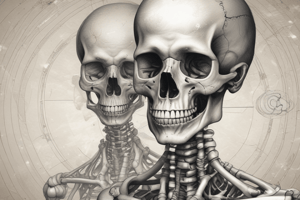Podcast
Questions and Answers
Which genetic disorder is caused by a dominant mutation?
Which genetic disorder is caused by a dominant mutation?
- Vitamin D-resistant rickets
- Hemophilia A
- Marfan syndrome (correct)
- Sickle cell anemia
In which mode of inheritance is the disorder typically more common in males than females?
In which mode of inheritance is the disorder typically more common in males than females?
- Autosomal dominant
- X-linked dominant
- Autosomal recessive
- X-linked recessive (correct)
What type of genetic mutation is primarily responsible for achondroplasia?
What type of genetic mutation is primarily responsible for achondroplasia?
- Recessive mutation
- Dominant mutation (correct)
- Environmental mutation
- Chromosomal abnormality
What is a common symptom associated with sickle cell anemia?
What is a common symptom associated with sickle cell anemia?
Which disorder is primarily caused by a lack of a substance needed for bone mineral absorption?
Which disorder is primarily caused by a lack of a substance needed for bone mineral absorption?
Which genetic disorder demonstrates a consequence of a single gene mutation?
Which genetic disorder demonstrates a consequence of a single gene mutation?
What characteristic is true of a mutant dominant allele?
What characteristic is true of a mutant dominant allele?
Which disorder is inherited in an autosomal recessive manner?
Which disorder is inherited in an autosomal recessive manner?
What is the role of carriers in genetic disorders?
What is the role of carriers in genetic disorders?
Which statement best describes the nature of genetic disorders caused by X-linked dominant mutations?
Which statement best describes the nature of genetic disorders caused by X-linked dominant mutations?
How is hemophilia A characterized in individuals who have the disorder?
How is hemophilia A characterized in individuals who have the disorder?
What type of genetic disorder is sickle cell anemia classified as?
What type of genetic disorder is sickle cell anemia classified as?
What process during meiosis can lead to chromosomal disorders?
What process during meiosis can lead to chromosomal disorders?
Which syndrome is characterized by having an extra copy of chromosome 21?
Which syndrome is characterized by having an extra copy of chromosome 21?
What is amniocentesis used for?
What is amniocentesis used for?
What is the possible outcome of fertilizing a gamete that results from nondisjunction?
What is the possible outcome of fertilizing a gamete that results from nondisjunction?
What is the main characteristic of Klinefelter syndrome?
What is the main characteristic of Klinefelter syndrome?
What does gene therapy aim to do?
What does gene therapy aim to do?
Which of the following is a common effect of Down syndrome?
Which of the following is a common effect of Down syndrome?
What is the approximate prevalence of single-gene disorders in the population?
What is the approximate prevalence of single-gene disorders in the population?
Achondroplasia is primarily a result of a recessive mutation.
Achondroplasia is primarily a result of a recessive mutation.
Sickle cell anemia is inherited in an autosomal recessive manner.
Sickle cell anemia is inherited in an autosomal recessive manner.
X-linked dominant disorders are more likely to affect females than males.
X-linked dominant disorders are more likely to affect females than males.
Hemophilia A is classified as an autosomal dominant disorder.
Hemophilia A is classified as an autosomal dominant disorder.
Mutant recessive alleles are typically expressed in individuals who inherit only one copy of them.
Mutant recessive alleles are typically expressed in individuals who inherit only one copy of them.
Match the genetic disorder with its direct effect of mutation:
Match the genetic disorder with its direct effect of mutation:
Match the genetic disorder with its mode of inheritance:
Match the genetic disorder with its mode of inheritance:
Match the signs and symptoms of the disorder to the appropriate genetic disorder:
Match the signs and symptoms of the disorder to the appropriate genetic disorder:
Match the mode of inheritance with its characteristic:
Match the mode of inheritance with its characteristic:
Match the genetic disorder with whether it is likely to affect males more than females:
Match the genetic disorder with whether it is likely to affect males more than females:
Flashcards are hidden until you start studying
Study Notes
Inheritance of Short Stature
- Achondroplasia is the most common form of dwarfism, caused by a dominant mutation.
- The mutation can be inherited from one generation to the next.
- Short stature can have genetic links, with some instances exhibiting familial patterns.
Genetic Disorders Overview
- Genetic disorders arise from mutations in one or more genes or abnormal chromosome numbers.
- Disorders result from either autosomal or X-linked mutations, affecting men and women differently.
Disorders Caused by Mutations
-
Marfan Syndrome:
- Caused by defective connective tissue protein.
- Symptoms include heart defects, bone abnormalities, and elongated limbs.
- Inherited in an autosomal dominant manner.
-
Sickle Cell Anemia:
- Results from abnormal hemoglobin, leading to sickle-shaped red blood cells.
- Symptoms include pain and organ damage.
- Inherited in an autosomal recessive pattern.
-
Vitamin D-resistant Rickets:
- Results from a lack of substance required for bone mineral absorption.
- Causes skeletal deformities like bowed legs.
- Inherited in an X-linked dominant manner.
-
Hemophilia A:
- Caused by reduced blood clotting protein activity.
- Symptoms include excessive bleeding.
- Inherited in an X-linked recessive pattern.
Dominant vs. Recessive Alleles
- Dominant alleles, if linked to a serious disorder, may lead to early death, thus reducing their frequency in the population.
- Recessive alleles can persist through carriers, who do not exhibit symptoms but can pass on the mutation to offspring.
Chromosomal Disorders and Nondisjunction
- Nondisjunction during meiosis leads to chromosome number abnormalities, resulting in disorders that often have severe effects.
- Example disorders include:
- Down Syndrome: extra chromosome 21, causing cognitive and physiological delays.
- Turner Syndrome: female with a single X chromosome (XO), characterized by short stature and infertility.
- Triple X Syndrome: females with three X chromosomes (XXX), causing mild developmental issues.
- Klinefelter Syndrome: males with additional X chromosomes (XXY, XXXY), leading to sexual development challenges and lower testosterone levels.
Diagnosing Genetic Disorders
- Genetic counselors assist individuals with family histories of disorders in understanding inheritance risks.
- Prenatal testing, such as amniocentesis, can identify genetic abnormalities in fetuses.
Treating Genetic Disorders
- While treatments for symptoms exist, cures remain in early development stages.
- Gene therapy shows promise by inserting normal genes into cells with mutations.
- Genetic testing for predisposition to disorders is increasingly available online, raising personal decision-making questions about potential risks for diseases like cancer.
Inheritance of Short Stature
- Achondroplasia is the most common form of dwarfism, caused by a dominant mutation.
- The mutation can be inherited from one generation to the next.
- Short stature can have genetic links, with some instances exhibiting familial patterns.
Genetic Disorders Overview
- Genetic disorders arise from mutations in one or more genes or abnormal chromosome numbers.
- Disorders result from either autosomal or X-linked mutations, affecting men and women differently.
Disorders Caused by Mutations
-
Marfan Syndrome:
- Caused by defective connective tissue protein.
- Symptoms include heart defects, bone abnormalities, and elongated limbs.
- Inherited in an autosomal dominant manner.
-
Sickle Cell Anemia:
- Results from abnormal hemoglobin, leading to sickle-shaped red blood cells.
- Symptoms include pain and organ damage.
- Inherited in an autosomal recessive pattern.
-
Vitamin D-resistant Rickets:
- Results from a lack of substance required for bone mineral absorption.
- Causes skeletal deformities like bowed legs.
- Inherited in an X-linked dominant manner.
-
Hemophilia A:
- Caused by reduced blood clotting protein activity.
- Symptoms include excessive bleeding.
- Inherited in an X-linked recessive pattern.
Dominant vs. Recessive Alleles
- Dominant alleles, if linked to a serious disorder, may lead to early death, thus reducing their frequency in the population.
- Recessive alleles can persist through carriers, who do not exhibit symptoms but can pass on the mutation to offspring.
Chromosomal Disorders and Nondisjunction
- Nondisjunction during meiosis leads to chromosome number abnormalities, resulting in disorders that often have severe effects.
- Example disorders include:
- Down Syndrome: extra chromosome 21, causing cognitive and physiological delays.
- Turner Syndrome: female with a single X chromosome (XO), characterized by short stature and infertility.
- Triple X Syndrome: females with three X chromosomes (XXX), causing mild developmental issues.
- Klinefelter Syndrome: males with additional X chromosomes (XXY, XXXY), leading to sexual development challenges and lower testosterone levels.
Diagnosing Genetic Disorders
- Genetic counselors assist individuals with family histories of disorders in understanding inheritance risks.
- Prenatal testing, such as amniocentesis, can identify genetic abnormalities in fetuses.
Treating Genetic Disorders
- While treatments for symptoms exist, cures remain in early development stages.
- Gene therapy shows promise by inserting normal genes into cells with mutations.
- Genetic testing for predisposition to disorders is increasingly available online, raising personal decision-making questions about potential risks for diseases like cancer.
Inheritance of Short Stature
- Achondroplasia is the most common form of dwarfism, caused by a dominant mutation.
- The mutation can be inherited from one generation to the next.
- Short stature can have genetic links, with some instances exhibiting familial patterns.
Genetic Disorders Overview
- Genetic disorders arise from mutations in one or more genes or abnormal chromosome numbers.
- Disorders result from either autosomal or X-linked mutations, affecting men and women differently.
Disorders Caused by Mutations
-
Marfan Syndrome:
- Caused by defective connective tissue protein.
- Symptoms include heart defects, bone abnormalities, and elongated limbs.
- Inherited in an autosomal dominant manner.
-
Sickle Cell Anemia:
- Results from abnormal hemoglobin, leading to sickle-shaped red blood cells.
- Symptoms include pain and organ damage.
- Inherited in an autosomal recessive pattern.
-
Vitamin D-resistant Rickets:
- Results from a lack of substance required for bone mineral absorption.
- Causes skeletal deformities like bowed legs.
- Inherited in an X-linked dominant manner.
-
Hemophilia A:
- Caused by reduced blood clotting protein activity.
- Symptoms include excessive bleeding.
- Inherited in an X-linked recessive pattern.
Dominant vs. Recessive Alleles
- Dominant alleles, if linked to a serious disorder, may lead to early death, thus reducing their frequency in the population.
- Recessive alleles can persist through carriers, who do not exhibit symptoms but can pass on the mutation to offspring.
Chromosomal Disorders and Nondisjunction
- Nondisjunction during meiosis leads to chromosome number abnormalities, resulting in disorders that often have severe effects.
- Example disorders include:
- Down Syndrome: extra chromosome 21, causing cognitive and physiological delays.
- Turner Syndrome: female with a single X chromosome (XO), characterized by short stature and infertility.
- Triple X Syndrome: females with three X chromosomes (XXX), causing mild developmental issues.
- Klinefelter Syndrome: males with additional X chromosomes (XXY, XXXY), leading to sexual development challenges and lower testosterone levels.
Diagnosing Genetic Disorders
- Genetic counselors assist individuals with family histories of disorders in understanding inheritance risks.
- Prenatal testing, such as amniocentesis, can identify genetic abnormalities in fetuses.
Treating Genetic Disorders
- While treatments for symptoms exist, cures remain in early development stages.
- Gene therapy shows promise by inserting normal genes into cells with mutations.
- Genetic testing for predisposition to disorders is increasingly available online, raising personal decision-making questions about potential risks for diseases like cancer.
Studying That Suits You
Use AI to generate personalized quizzes and flashcards to suit your learning preferences.




